Themed collection 2021 Soft Matter Emerging Investigators

Soft Matter Emerging Investigators 2021
This themed collection of Soft Matter highlights the work of emerging investigators in the field of soft matter. Editor-in-Chief Darrin Pochan introduces the issue.

Soft Matter, 2021,17, 3532-3532
https://doi.org/10.1039/D1SM90050A
Unravelling the antimicrobial activity of peptide hydrogel systems: current and future perspectives
The use of hydrogels has garnered significant interest as biomaterial and drug delivery platforms for anti-infective applications.
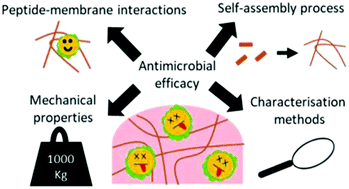
Soft Matter, 2021,17, 8001-8021
https://doi.org/10.1039/D1SM00839K
The dynamic face of lipid membranes
Lipid membranes envelope live cells and mediate vital biological functions through regulated spatiotemporal dynamics. This review highlights the role of neutron scattering, among other approaches, in uncovering the dynamic properties of lipid membranes.
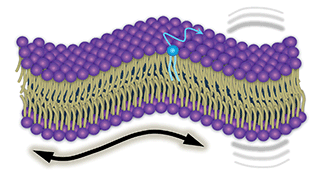
Soft Matter, 2021,17, 6910-6928
https://doi.org/10.1039/D1SM00646K
Dynamics in supramolecular nanomaterials
Properties of supramolecular nanostructures are mediated by conformational, exchange, and water dynamics. Here we review experimental methods and recent reports of dynamics characterization of small molecule nanomaterials.
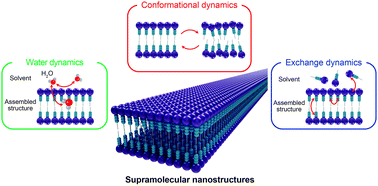
Soft Matter, 2021,17, 5850-5863
https://doi.org/10.1039/D1SM00047K
More than just a barrier: using physical models to couple membrane shape to cell function
Physical models can help us to infer, from the shape of the outer membrane, which biological processes happen inside the living cell.
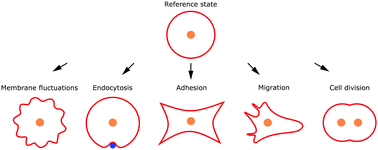
Soft Matter, 2021,17, 3533-3549
https://doi.org/10.1039/D0SM01758B
Stimuli-responsive engineered living materials
Engineered living materials integrate genetic engineering and synthetic materials to program stimuli responses that enable the fabrication of devices for diverse applications.
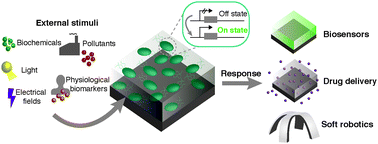
Soft Matter, 2021,17, 785-809
https://doi.org/10.1039/D0SM01905D
Electrohydrodynamics of droplets and jets in multiphase microsystems
Electrohydrodynamics is among the most promising techniques for manipulating liquids in microsystems.

Soft Matter, 2020,16, 8526-8546
https://doi.org/10.1039/D0SM01357A
Molecular understanding for large deformations of soft bottlebrush polymer networks
We discover a new regime in which the extensibility of bottlebrush polymer networks is inversely proportional to the network stiffness.

Soft Matter, 2020,16, 6259-6264
https://doi.org/10.1039/D0SM00759E
Glassy dynamics of sticky hard spheres beyond the mode-coupling regime
Generalized mode-coupling theory, a first-principles-based theory, systematically improves the prediction of phase diagrams for sticky hard spheres.
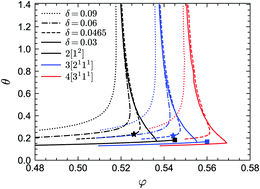
Soft Matter, 2021,17, 7645-7661
https://doi.org/10.1039/D1SM00712B
Interfacially-adsorbed particles enhance the self-propulsion of oil droplets in aqueous surfactant
The adsorption of solid particles on the surface of solubilizing oil droplets can significantly enhance the droplets’ self-propulsion speeds.

Soft Matter, 2021,17, 6742-6750
https://doi.org/10.1039/D0SM02234A
On the relationship between cutting and tearing in soft elastic solids
Unique observations of cutting energy in silicone elastomers motivate a picture of soft fracture that qualitatively and quantitatively links far-field tearing with push cutting for the first time.
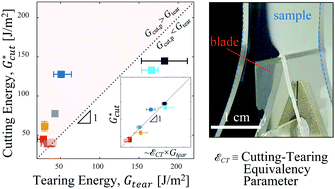
Soft Matter, 2021,17, 6728-6741
https://doi.org/10.1039/D1SM00527H
Phase behavior and surface tension of soft active Brownian particles
We study quasi two-dimensional, monodisperse systems of active Brownian particles (ABPs) for a range of activities, stiffnesses, and densities.
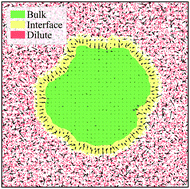
Soft Matter, 2021,17, 6337-6351
https://doi.org/10.1039/D1SM00350J
Dynamics and extensional rheology of polymer–surfactant association complexes
We find the aqueous PEO–SDS mixtures show a significantly weaker concentration-dependent variation in the extensional relaxation time, filament lifespan, and extensional viscosity values than anticipated by the shear viscosity vs. concentration plots.
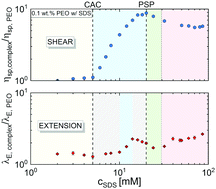
Soft Matter, 2021,17, 6116-6126
https://doi.org/10.1039/D1SM00335F
Collective dynamics in lipid membranes containing transmembrane peptides
Small amounts of transmembrane peptides can significantly alter the collective dynamics in lipid membranes even when there are no changes in the average membrane structure.

Soft Matter, 2021,17, 5671-5681
https://doi.org/10.1039/D1SM00314C
Investigating the structural properties of hydrophobic solvent-rich lipid bilayers
In vitro reconstitutions of lipid membranes can contain residual hydrophobic solvents. We investigate the influence of residual solvents on lipid bilayers properties using Molecular Dynamics simulations.

Soft Matter, 2021,17, 5329-5335
https://doi.org/10.1039/D0SM02270E
Dynamical time scales of friction dynamics in active microrheology of a model glass
Owing to the local/heterogeneous structures in supercooled liquids, after several decades of research, it is now clear that supercooled liquids are structurally different from their conventional liquid counterparts.
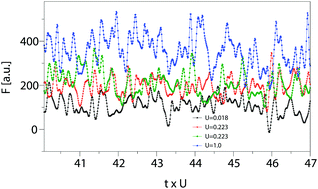
Soft Matter, 2021,17, 5162-5169
https://doi.org/10.1039/D0SM02039G
Design of vesicle prototissues as a model for cellular tissues
Biomimetic vesicle prototissues have been designed as a model for cellular tissues. Prototissues display spheroidal or sheet like morphologies, and have predictable vesicle–vesicle adhesion strengths, typical sizes, and degree of compaction.

Soft Matter, 2021,17, 5061-5072
https://doi.org/10.1039/D1SM00336D
Poroelastic shape relaxation of hydrogel particles
We describe a straightforward way to determine the poroelastic diffusion coefficient of a hydrogel particle by first indenting it via swelling in a granular packing, and then monitoring how its indented shape relaxes after it is removed.
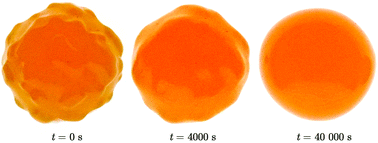
Soft Matter, 2021,17, 3840-3847
https://doi.org/10.1039/D0SM02243H
Emergence and stabilization of transient twisted defect structures in confined achiral liquid crystals at a phase transition
We report a transient twist observed in common thermotropic, achiral liquid crystals at the transition between the smectic and the nematic phase. This is explained with the combined effect of the change of the elastic constants at the phase transition and of the confining geometry.

Soft Matter, 2021,17, 3848-3854
https://doi.org/10.1039/D0SM02040K
Air mediates the impact of a compliant hemisphere on a rigid smooth surface
When a soft elastic body impacts upon a smooth solid surface, the intervening air fails to drain, deforming the impactor. High-speed imaging with the VFT reveal rich dynamics and sensitivity to the impactor's elastic properties and the impact velocity.
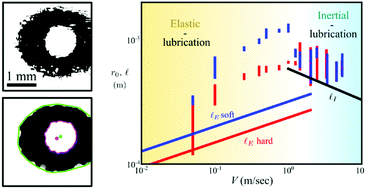
Soft Matter, 2021,17, 3813-3819
https://doi.org/10.1039/D0SM02163F
Adhesion as a trigger of droplet polarization in flowing emulsions
When adhesive emulsions are flowed in 2D constrictions, their local rearrangements are impaired, leading to higher deformations. The adhesive emulsions are globally more aligned in the direction of elongation, leading to a global polarization.

Soft Matter, 2021,17, 3820-3828
https://doi.org/10.1039/D1SM00097G
Near-surface rheology and hydrodynamic boundary condition of semi-dilute polymer solutions
Using evanescent wave microscopy to study near-surface, semi-dilute polymer solution flows provides simultaneous access to the mechanical behaviour of the liquid and the boundary condition at the interfaces. Our results highlight the importance of electrostatic interactions between the polymers and the bounding wall.

Soft Matter, 2021,17, 3765-3774
https://doi.org/10.1039/D0SM02116D
Modelling the dynamics of vesicle reshaping and scission under osmotic shocks
We study dynamic reshaping of lipid vesicles under osmotic shocks via molecular dynamics simulations. We identified rich morphology transformations, and observed a separation of time scales between the shock absorption and the shape relaxation.
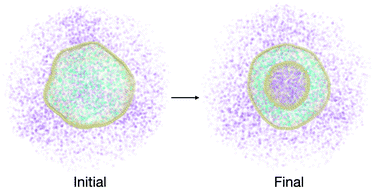
Soft Matter, 2021,17, 3798-3806
https://doi.org/10.1039/D0SM02012E
Propulsion of an elastic filament in a shear-thinning fluid
Via a simple elastic swimmer actuated magnetically, we present a first study to examine how shear-thinning rheology impacts the fluid-structure interaction and hence the elastohydrodynamic propulsion performance at low Reynolds numbers.
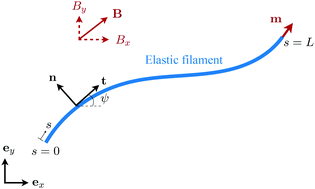
Soft Matter, 2021,17, 3829-3839
https://doi.org/10.1039/D0SM02130J
Universality class of the motility-induced critical point in large scale off-lattice simulations of active particles
Performing large-scale simulations of active particles and employing finite-size-scaling analysis, we provide exhaustive evidence that motility-induced critical point belongs to the Ising universality class.
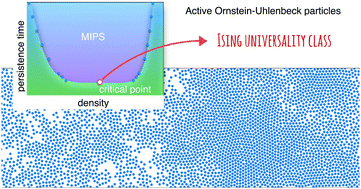
Soft Matter, 2021,17, 3807-3812
https://doi.org/10.1039/D0SM02162H
Designing responsive dressings for inflammatory skin disorders; encapsulating antioxidant nanoparticles into biocompatible electrospun fibres
Antioxidant polysulfide nanoparticles can be electrospun within nanofibre scaffold patches to provide anti-inflammatory action.
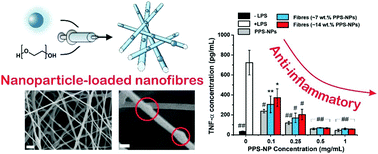
Soft Matter, 2021,17, 3775-3783
https://doi.org/10.1039/D0SM01987A
Phase mechanics of colloidal gels: osmotic pressure drives non-equilibrium phase separation
Negative osmotic pressure drives non-equilibrium phase separation of “reversible” colloidal gels subjected to weak external stress, manifesting as yield under fully intact network.

Soft Matter, 2021,17, 3784-3797
https://doi.org/10.1039/D0SM02180F
Electrostatic wrapping of a microfiber around a curved particle
Using experiments and modeling, we study the spontaneous wrapping of a negatively charged microfiber around a positively charged disk-shaped particle immersed in a liquid.
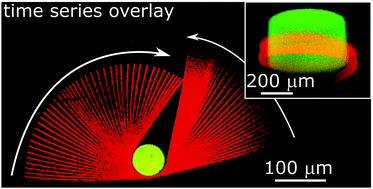
Soft Matter, 2021,17, 3609-3618
https://doi.org/10.1039/D0SM01857K
Emergent cell-free layer asymmetry and biased haematocrit partition in a biomimetic vascular network of successive bifurcations
We describe, characterise and explain emerging heterogeneity of red bolood cell partitioning within a network substantially deviating from empirical predictions.

Soft Matter, 2021,17, 3619-3633
https://doi.org/10.1039/D0SM01845G
Onsager's variational principle in active soft matter
Onsager's variational principle is extended and applied to the dynamic modeling of active soft matter such as the directional motion of individual self-propelled units and the dynamics of active polar droplets on solid substrates.

Soft Matter, 2021,17, 3634-3653
https://doi.org/10.1039/D0SM02076A
Orienting and shaping organic semiconductor single crystals through selective nanoconfinement
Nanoconfining scaffolds can be used to orient and shape organic semiconductor crystals during solution-phase crystallization depending on the scaffold geometry and the native crystal growth habit.
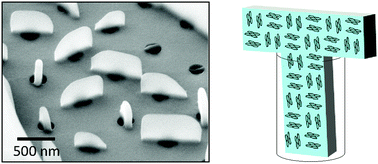
Soft Matter, 2021,17, 3603-3608
https://doi.org/10.1039/D0SM01928C
Coarse-grained nucleic acid–protein model for hybrid nanotechnology
A coarse-grained model for analysis and design of hybrid DNA-protein nanoscale structures.
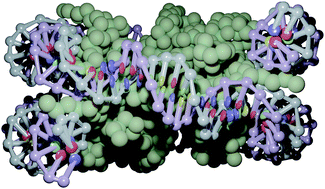
Soft Matter, 2021,17, 3586-3593
https://doi.org/10.1039/D0SM01639J
Disentangling collective motion and local rearrangements in 2D and 3D cell assemblies
We propose a new tracking-free method for the quantification of multiscale dynamics in 2D and 3D cell collectives.
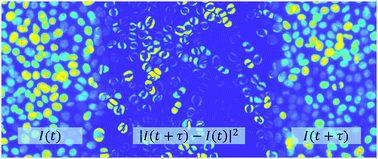
Soft Matter, 2021,17, 3550-3559
https://doi.org/10.1039/D0SM01837F
Wetting equilibrium in a rectangular channel
Wetting in a nearly rectangular channel.
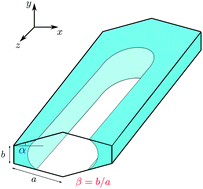
Soft Matter, 2021,17, 3594-3602
https://doi.org/10.1039/D0SM01727B
Controlling uniform patterns by evaporation of multi-component liquid droplets in a confined geometry
A drying multi-component liquid droplet in a confined geometry leaves a uniform dried pattern. The evaporated vapors are stagnated inside the closed chamber, which induce Marangoni effects that contribute to suppress the coffee-ring pattern.
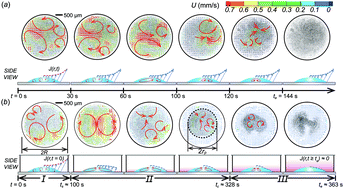
Soft Matter, 2021,17, 3578-3585
https://doi.org/10.1039/D0SM01872D
Magttice: a lattice model for hard-magnetic soft materials
Magnetic actuation has emerged as a powerful and versatile mechanism for diverse applications, ranging from soft robotics, biomedical devices to functional metamaterials.
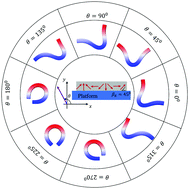
Soft Matter, 2021,17, 3560-3568
https://doi.org/10.1039/D0SM01662D
Effect of precise linker length, bond density, and broad temperature window on the rheological properties of ethylene vitrimers
Dynamic networks with precise spacers between boronic ester bonds were investigated over a broad temperature window. Arrhenius behavior breaks down and an increase in relaxation time is observed when approach the glass transition temperature.
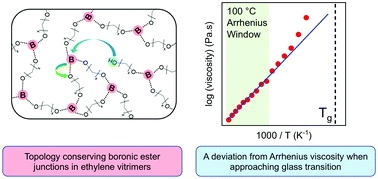
Soft Matter, 2021,17, 3569-3577
https://doi.org/10.1039/D0SM01544J
Stabilizing liquid drops in nonequilibrium shapes by the interfacial crosslinking of nanoparticles
We show that the Plateau–Rayleigh instability can be suppressed by the interfacial self-assembly and crosslinking of nanoparticles, potentially introducing a new approach for additive manufacturing.

Soft Matter, 2021,17, 2034-2041
https://doi.org/10.1039/D0SM02120B
Deterministic control of adhesive crack propagation through jamming based switchable adhesives
We show deterministic control of adhesive crack initiation, propagation, and arresting by integrating a granular jamming layer into adhesive films.
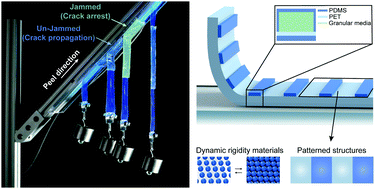
Soft Matter, 2021,17, 1731-1737
https://doi.org/10.1039/D0SM02129F
Controlling nanostructure and mechanical properties in triblock copolymer/monomer blends via reaction-induced phase transitions
In situ polymer grafting from the mid-block of an ABA triblock copolymer leads to morphology transitions and enhanced mechanical properties.
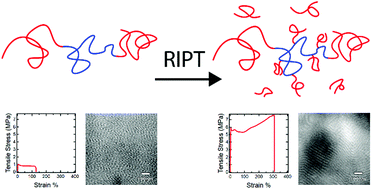
Soft Matter, 2021,17, 1505-1512
https://doi.org/10.1039/D0SM01661F
Gel rupture during dynamic swelling
A complex, three-stage fracture process is described for hydrogels, resulting in material failure. This process is markedly different than that observed in brittle materials, and we describe how this process varies with network architecture.

Soft Matter, 2021,17, 1513-1520
https://doi.org/10.1039/D0SM01718C
Decoupling salt- and polymer-dependent dynamics in polyelectrolyte complex coacervates via salt addition
A method for changing the salt and polymer concentrations of coacervates independently is developed and used to investigate their rheology.
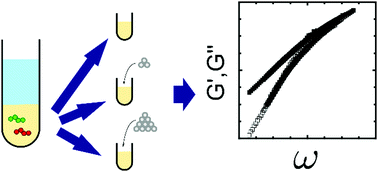
Soft Matter, 2021,17, 1223-1231
https://doi.org/10.1039/D0SM01412E
Optical quantification of intracellular mass density and cell mechanics in 3D mechanical confinement
Optical quantification of intracellular mass density using optical diffraction tomography (ODT) and cell mechanics using Brillouin spectroscopy under 3D mechanical confinement.
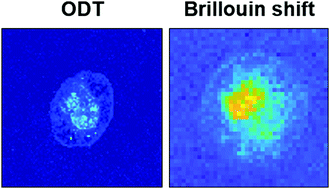
Soft Matter, 2021,17, 853-862
https://doi.org/10.1039/D0SM01556C
Pressure tunable adhesion of rough elastomers
The adhesion of rough surfaces comprised of dewetted thermoplastic asperities on an elastomer is controlled by changing the applied compressive load.
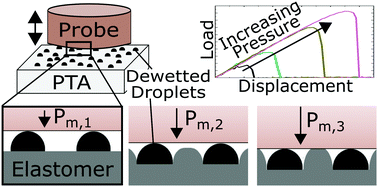
Soft Matter, 2021,17, 863-869
https://doi.org/10.1039/D0SM01754J
Using reactive dissipative particle dynamics to understand local shape manipulation of polymer vesicles
Biological cells have long been of interest to researchers due to their capacity to actively control their shape.

Soft Matter, 2021,17, 24-39
https://doi.org/10.1039/D0SM01654C
Characterization of N-phenylmaleimide-terminated poly(ethylene glycol)s and their application to a tetra-arm poly(ethylene glycol) gel
Characterization of N-phenylmaleimide-terminated poly(ethylene glycol)s and their application to a tetra-arm poly(ethylene glycol) gels
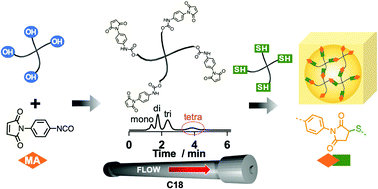
Soft Matter, 2020,16, 10869-10875
https://doi.org/10.1039/D0SM01658F
Diffuso-kinetic membrane budding dynamics
A wide range of proteins create shape transformations of membranes. The remodeling is a coupling between the energetic cost of membrane bending, protein recruitment which induce local spontaneous curvature and protein diffusion on the membrane.

Soft Matter, 2020,16, 10889-10899
https://doi.org/10.1039/D0SM01028F
Apparent phototaxis enabled by Brownian motion
To improve the understanding of phototaxis, we investigate the origin of our photocatalytic particles’ peculiar scotophobicity (fear of darkness).
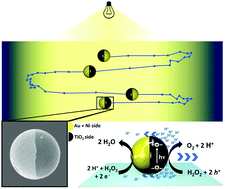
Soft Matter, 2020,16, 10585-10590
https://doi.org/10.1039/D0SM01603A
Free-energy landscape of polymer-crystal polymorphism
Free-energy landscape of crystallized syndiotactic-polystyrene polymorphism from quantum-mechanical calculations and coarse-grained simulations.
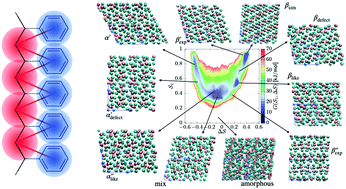
Soft Matter, 2020,16, 9683-9692
https://doi.org/10.1039/D0SM01342K
Lyotropic liquid crystal phase behavior of a cationic amphiphile in aqueous and non-stoichiometric protic ionic liquid mixtures
Protic ionic liquids (PILs) are the largest and most tailorable known class of non-aqueous solvents which possess the ability to support amphiphile self-assembly.
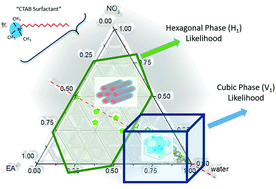
Soft Matter, 2020,16, 9456-9470
https://doi.org/10.1039/D0SM01298J
Bridging experiments and theory: isolating the effects of metal–ligand interactions on viscoelasticity of reversible polymer networks
A systematic study of the effect of metal–ligand interactions on the viscoelastic properties of the reversible polymer networks.
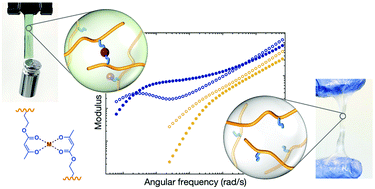
Soft Matter, 2020,16, 8591-8601
https://doi.org/10.1039/D0SM01115K
Connecting particle clustering and rheology in attractive particle networks
We introduce graph theory measures and demonstrate how transitions in microstructural conformations can be quantified and correlated to the rheology.
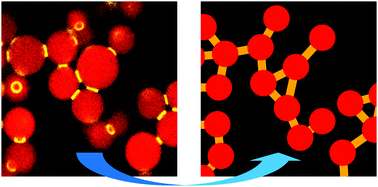
Soft Matter, 2020,16, 8380-8393
https://doi.org/10.1039/D0SM00861C
Peak force visible microscopy
We developed a new type of visible-range photothermal microscopy for measurement of optical absorption with excellent spatial resolution.
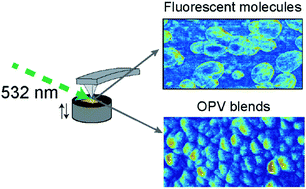
Soft Matter, 2020,16, 8372-8379
https://doi.org/10.1039/D0SM01104E
On the lipid flip-flop and phase transition coupling
We measured by neutron reflectometry the loss of asymmetry in solid supported lipid bilayers, revealing an intrinsic interplay between passive lipid flip-flop and lipid phase transition.
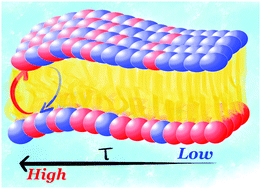
Soft Matter, 2020,16, 7696-7703
https://doi.org/10.1039/D0SM01161D
Anomalous and heterogeneous DNA transport in biomimetic cytoskeleton networks
The cytoskeleton, a complex network of protein filaments and crosslinking proteins, dictates diverse cellular processes ranging from division to cargo transport.
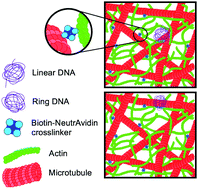
Soft Matter, 2020,16, 6344-6353
https://doi.org/10.1039/D0SM00544D
Mechanical interplay between cell shape and actin cytoskeleton organization
(Right) Optical micrograph (TRITC–Phalloidin) of a fibroblastoid cell. (Left) Configuration obtained from theoretical model using the adhesion sites of the experimental data as input.
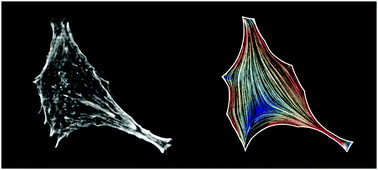
Soft Matter, 2020,16, 6328-6343
https://doi.org/10.1039/D0SM00492H
About this collection
Soft Matter is proud to present this 2021 Emerging Investigators collection. This collection gathers the very best work from soft matter scientists in the early stages of their independent careers. The 2021 Soft Matter Emerging Investigators were individually nominated by members of the journal Editorial and Advisory Boards, and previous Emerging Investigators, in recognition of their potential to influence future directions in the field of soft matter.
Articles will be added to this collection as and when they are ready to be published, accompanied by an Editorial piece in the coming months.